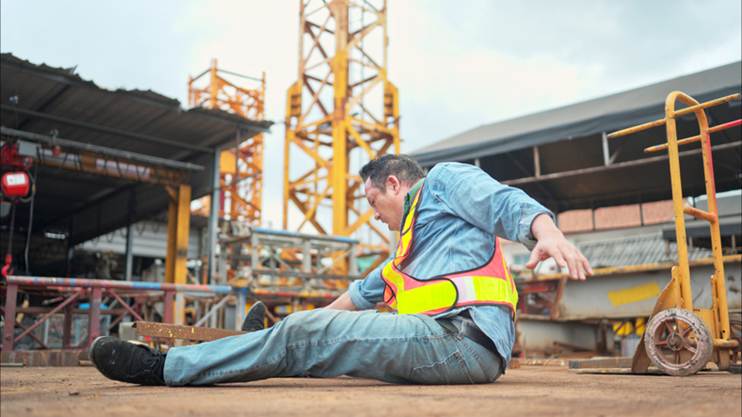
Construction Site Slip and Falls: Liability and Claims
One Misstep, One Life Changed Forever
One misplaced tool or slick walkway can send you to the ground in a heartbeat, and suddenly, everything changes. You’re dealing with pain, missed paychecks, and medical bills you never saw coming. It’s overwhelming, especially when someone else’s carelessness is to blame. That’s when experienced construction accident attorneys step in to help you take back control.
At Horn Wright, LLP, we help injured workers fight back with a deep understanding of how construction-related injury laws work. While regulations may differ between states like Maine, Vermont, and New Hampshire, what doesn’t change is the importance of having someone on your side who knows how to protect your rights and fight for the outcome you deserve.

Hidden Hazards and Life-Altering Falls on the Job
Construction work doesn’t just come with obvious risks. It hides a thousand small dangers in plain sight. From the ground to the scaffolding above, one slip can flip your world in an instant.
Chaos Beneath the Crane: What They Don’t Warn You About
Construction sites move fast. With tight deadlines and crowded crews, danger can quietly blend in. A recent report revealed a 48% jump in worker deaths in just one year.
The biggest risks are often the ones you don’t see coming. Skipped inspections or unmarked hazards can quickly turn into serious consequences for workers like you.
Some of the most overlooked hazards include:
- Wet or uneven surfaces: Concrete slabs still drying, ice in winter, or water from poorly maintained machinery can make walkways dangerously slick. These are some of the most common hazards in slip and fall accidents seen across construction sites.
- Obstructed paths: Cables, power tools, and buckets left in walking paths become tripping hazards in seconds.
- Unmarked hazards: Missing warning signs around open pits, scaffolding edges, or stairwells.
- Improper lighting: Poor visibility at night or indoors can lead to serious injury. Poor lighting-related accidents often go unaddressed until it’s too late.
In hectic environments, small hazards grow fast. When ignored, they can cause serious injuries that disrupt your life and livelihood. Recognizing these dangers early is key to staying safe on the job.
From a Skid on Steel to a Life in Recovery
A slip on a construction site might seem minor, but it can lead to serious harm like fractures, spinal injuries, or head trauma, especially if you fall on concrete or steel. These incidents are often tied to defective stairways or unstable flooring and occur when safety equipment is missing or fails.
One accident can end a career, and when poor oversight or tight deadlines play a role, someone needs to be held accountable. Construction accident attorneys can help uncover the cause and pursue justice.
Who’s Really to Blame When the Sidewalk Turns Into an ER Visit?
It’s not always clear who’s at fault after a fall, but finding the answer starts by looking at who had control of the site. Before you can hold anyone accountable, you need to understand who was supposed to protect your safety in the first place.
Who Was Responsible for Keeping the Site Safe and Failed?
Responsibility isn’t just about who was present at the time. It’s about who had the authority to prevent danger and didn’t. Identifying that party is often the first step toward getting the answers you deserve.
Here are the parties who may be legally responsible for keeping the site safe:
- General contractors: They oversee site-wide safety and are responsible for protecting all workers.
- Subcontractors: When tools or debris are left in unsafe places, they could be held accountable.
- Property owners: Under Labor Law Sections 240, and 241, owners may be liable for failing to maintain a safe environment during scaffolding, demolition, or excavation work.
- Site supervisors or foremen: They must enforce safety rules, monitor gear usage, and maintain hazard-free work areas.
Understanding who had the legal responsibility to protect your safety can clarify your legal options and help you pursue the right course forward. This knowledge helps you target the right party. It also strengthens your case from the start.
How to Show the Judge That Your Fall Was No Accident
Insurance companies often try to shift the blame and question everything about the incident, including what you were doing or whether you saw the hazard.
To counter this, you need proof that someone was responsible for keeping the site safe, failed to do it, and that failure caused your injury. Medical records, witness accounts, or photos can help draw a clear connection. Even if you’re working as an independent contractor or day laborer, you have rights under slip and fall protections, especially when unsafe conditions are involved.
What Proves Your Story When the Dust Clears?
Here’s the deal: a strong claim doesn’t mean a perfect story. What matters most is solid, clear evidence. Photos. Reports. Eyewitnesses. The more detailed your documentation, the better chance you have of being taken seriously.
Snapshots, Signatures, and Statements: The Proof That Holds Up
Not sure what kind of proof actually helps? The goal is to build a clear, believable picture of what happened using solid, detailed evidence.
If you’re able to act quickly after a fall, focus on these key pieces of evidence that strengthen your story:
- Photographs: Take clear images of the hazard, the area around it, and anything that shows missing safety measures. Capturing clear, timely images can be the difference between a weak and strong claim.
- Witness statements: Coworkers or others on site who saw the fall can confirm what happened and support your version. Inconsistent stories can weaken your case, as explored in why some personal injury cases take longer than expected.
- Accident reports: A report from your supervisor with a timestamp can help confirm your timeline.
- Medical records: These documents show the injuries and link them directly to the fall.
On busy construction sites, nearby surveillance footage from adjacent buildings or businesses can also help support your claim. When every detail aligns with your version of events, your case becomes much harder to dispute.
Blink and It’s Gone: Why Every Hour After the Fall Matters
Construction sites shift fast, and hazards can disappear before you know it. If you’re injured, act quickly. Report it, document the scene, get medical care, and avoid giving detailed statements to insurance representatives without legal advice. With the statute of limitations limiting your time to take action, fast steps protect your rights and preserve the evidence you need.
When a Fall Shakes Your Future, You Deserve a Strong Ally
A serious fall on a construction site can do more than injure your body. It can shake your sense of stability, your livelihood, and your confidence. You shouldn’t be left to carry that weight without support.
Reach out to Horn Wright, LLP, to speak with construction accident attorneys who understand exactly what you’re up against. You’ve got questions, and we’re here to give you answers that matter. Let’s find a path forward, together.

What Sets Us Apart From The Rest?
Horn Wright, LLP is here to help you get the results you need with a team you can trust.
-
Client-Focused ApproachWe’re a client-centered, results-oriented firm. When you work with us, you can have confidence we’ll put your best interests at the forefront of your case – it’s that simple.
-
Creative & Innovative Solutions
No two cases are the same, and neither are their solutions. Our attorneys provide creative points of view to yield exemplary results.
-
Experienced Attorneys
We have a team of trusted and respected attorneys to ensure your case is matched with the best attorney possible.
-
Driven By Justice
The core of our legal practice is our commitment to obtaining justice for those who have been wronged and need a powerful voice.

